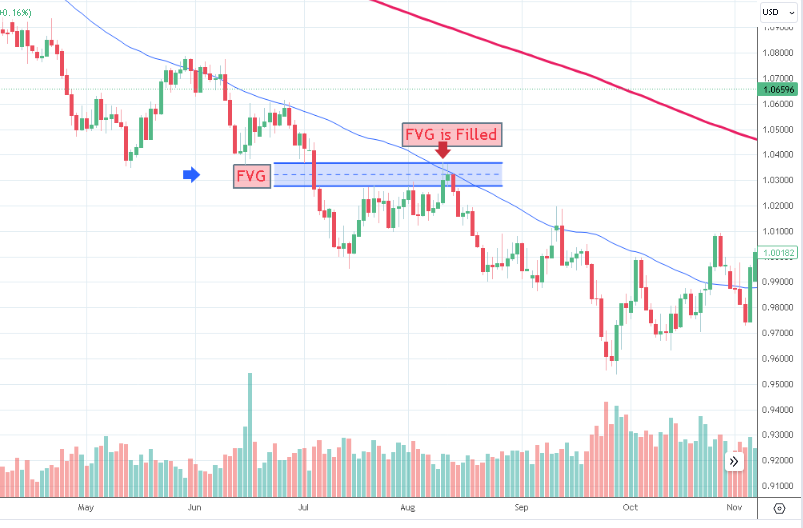FVG (Fair Value Gap) Meaning in Forex



Editorial Note: While we adhere to strict Editorial Integrity, this post may contain references to products from our partners. Here's an explanation for How We Make Money. None of the data and information on this webpage constitutes investment advice according to our Disclaimer.
The fair value gap in Forex refers to the discrepancy between the exchange rate of a currency pair and its calculated fair value. Traders often look for opportunities to exploit this gap, as they believe that over time, exchange rates tend to converge towards their fair values.
A Fair Value Gap (FVG) in Forex trading is the discrepancy between a currency's current market price and its perceived intrinsic value. The FVG concept is highly popular among traders, but it comes with significant drawbacks. Let’s learn more about FVG.
Top 3 term in this article:
Mean Reversal - a trading strategy that assumes that an asset's price will tend to revert to its historical mean or average price over time after deviating from it, creating potential buying or selling opportunities.
Fundamental analysis is the evaluation of an asset's value based on factors like economic indicators, financial health, and geopolitical events.
Technical analysis is the study of historical price data and chart patterns to predict future price movements.
What is a Fair Value Gap concept in simple words?
A Fair Value Gap (FVG) in Forex trading is essentially the difference between the current market price of a currency pair and what it's believed to be worth based on economic factors or reversion to the mean idea in technical analysis. Market price deviates significantly from this estimated "fair value," it can signal potential trading opportunities.
Several factors can cause an FVG to appear. It often arises from market sentiment, economic news, or geopolitical events that temporarily push a currency's price above or below its fundamental value. These imbalances can be exploited by traders looking to profit from price corrections.
How to spot a FVG
There are different approaches to Fair Value Gap (FVG) trading. One relies on fundamental analysis, where traders assess how much the market price deviates from the fundamental valuation of an asset and react to events that can influence those fundamental factors. The other approach is based on technical analysis, where traders study historical price data and chart patterns to identify significant price imbalances.
FVG in Forex fundamental analysis
For instance, if a model suggests that the fair value range for a currency pair is between 1.1 and 1.2, and the pair has been trading within this range for an extended period, a significant price drop below, say, 1.085, following emotional market reactions to non-fundamental news, can create an FVG. In this scenario, a trader may decide to buy the currency pair at a lower price than its estimated fair value, anticipating that the price will eventually return to the established range as market emotions subside.
FVG in technical analysis example
Suppose a currency pair had been trading within a relatively stable range for several months, considering its fair value. However, due to unexpected economic news, a gap formed as the price dropped. Eventually, this gap was filled as the price reverted to its previous trading range border.
 FVG example
FVG exampleWhat is the trading idea behind FVG?
One of the key trading ideas behind Fair Value Gap (FVG) trading is the belief that all gaps in the price of a currency pair will eventually be filled. This concept is often referred to as "gap filling" or "mean reversion". The rationale behind this idea is that when a currency's price deviates significantly from its perceived fair value, it creates an imbalance in the market.
Traders who follow this principle assume that markets tend to correct themselves over time. So, if a currency pair experiences a gap where the price is substantially higher or lower than its fair value, there is an expectation that the price will eventually revert back to that fair value.
This trading strategy often involves taking positions to profit from the anticipated price correction. Traders may enter trades in the direction they expect the gap to be filled, either by buying if they anticipate the price will rise to close the gap or selling if they expect it to fall.
Where to trade Forex?
It is crucial for brokers have reliable international regulation, offer low commissions, and provide a low minimum deposit for beginners. We compared the top 3 brokers with the highest ratings according to our Forex brokers evaluation methodology.
| Regulation | Min Spread EUR/USD, pips | Max Spread EUR/USD, pips | Currency pairs | Stocks | Open account | |
|---|---|---|---|---|---|---|
| FCA, CySEC, MAS, ASIC, FMA, FSA (Seychelles) | 0,5 | 0,9 | 60 | Yes | Open an account Your capital is at risk. |
|
| ASIC, FCA, DFSA, BaFin, CMA, SCB, CySec | 0,5 | 1,5 | 90 | Yes | Open an account Your capital is at risk.
|
|
| FSC (BVI), ASIC, IIROC, FCA, CFTC, NFA | 0,1 | 0,5 | 68 | Yes | Open an account Your capital is at risk. |
Fair Value Gap criticism
The Fair Value Gap (FVG) concept is viewed skeptically by many traders due to its inherent drawbacks. FVG trading relies on the assumption that gaps will always be filled, but this is not guaranteed, leading to potential losses. Additionally, traders who solely rely on chart analysis may overlook critical fundamental factors, exposing themselves to market risks.
Some key drawback of FVG concepts are:
Markets can remain irrational for longer than traders can remain solvent, and not all gaps will necessarily close in the desired direction.
Not all apparent gaps on price charts are true Fair Value Gaps. Some may be caused by temporary market noise, such as low liquidity.
Relying solely on chart analysis may cause traders to overlook critical fundamental factors that influence currency values.
Occasionally, major events can lead to significant gaps that don't fill quickly or ever. These so-called "breakaway gaps" can result in substantial losses for traders who assume all gaps will eventually close.
Placing stop-loss orders to manage risk in FVG trading can be challenging due to the potential for sudden, unpredictable gap movements, which can trigger stop-loss orders at unfavorable prices.
How to improve the FVG trading strategy?
To enhance your performance in trading the FVG concept, it's crucial to adopt a well-rounded approach that combines a deep understanding of fundamental analysis with technical analysis (TA). Here's how this synergy can potentially lead to better results:
Develop a comprehensive grasp of macroeconomic factors that influence currency values. Monitor economic indicators, central bank policies, geopolitical events, and trade developments in the countries involved. This fundamental understanding will help you assess whether a perceived gap is driven by real changes in the economic landscape.
Utilize technical analysis tools, such as candlestick patterns, support/resistance levels, and technical indicators, to pinpoint entry and exit points. While FVG trading relies on fundamental analysis, technical analysis can provide specific timing and price level insights.
Look for confirmation signals from both fundamental and technical analysis. For instance, if you identify a gap on the chart as an FVG opportunity, ensure that it aligns with underlying economic factors and is supported by technical indicators like RSI or moving averages.
Implement robust risk management strategies, including setting stop-loss orders and position sizing. For every gap that gets filled in the near term, there are often several that remain unfilled for months, and some gaps may never be filled, highlighting the critical importance of having a strict risk management strategy.
FVG trading can be complex and requires a level of experience and expertise. Novice traders may find it challenging to navigate the nuances of macroeconomic analysis and the complexities of Forex markets. However, the FVG concept can be a powerful trading strategy when executed by experienced traders who possess a deep understanding of macroeconomic analysis.
FAQs
What is the FVG imbalance indicator?
Several developers have created indicators designed to identify liquidity voids or imbalances related to Fair Value Gaps (FVG). For instance, one such indicator, like "The Liquidity Voids (FVG)" available on TradingView, aims to spot these voids resulting from FVGs and emphasize their distribution at particular price levels.
Do fair value gaps always get filled?
No. New information or fundamental shifts in market sentiment may permanently alter the asset's value. Additionally, unforeseen events and liquidity issues can lead to gaps that defy traditional gap-filling expectations, making it essential for traders to exercise caution and use stop-loses.
Is fair value gap strategy profitable?
The profitability of the strategy strongly depends on the trader's approach and their ability to execute it effectively. When implemented with a well-thought-out plan, deep understanding of fundamental and technical factors, disciplined risk management, and adaptability to changing market conditions, the FVG strategy can be profitable.
How often do gaps get filled in trading?
While there are no specific statistics, historical data and market analysis suggest that a significant portion of gaps do tend to get filled, especially in more liquid and efficient markets. However, it's essential for traders to exercise caution because not all gaps will be filled, and some may persist for extended periods, possibly even years, due to shifts in market sentiment or fundamental changes.
Related Articles
Team that worked on the article
Andrey Mastykin is an experienced author, editor, and content strategist who has been with Traders Union since 2020. As an editor, he is meticulous about fact-checking and ensuring the accuracy of all information published on the Traders Union platform. Andrey focuses on educating readers about the potential rewards and risks involved in trading financial markets.
He firmly believes that passive investing is a more suitable strategy for most individuals. Andrey's conservative approach and focus on risk management resonate with many readers, making him a trusted source of financial information.
Also, Andrey is a member of the National Union of Journalists of Ukraine (membership card No. 4574, international certificate UKR4492).

Dr. BJ Johnson is a PhD in English Language and an editor with over 15 years of experience. He earned his degree in English Language in the U.S and the UK. In 2020, Dr. Johnson joined the Traders Union team. Since then, he has created over 100 exclusive articles and edited over 300 articles of other authors.
Mirjan Hipolito is a journalist and news editor at Traders Union. She is an expert crypto writer with five years of experience in the financial markets. Her specialties are daily market news, price predictions, and Initial Coin Offerings (ICO).
CFD is a contract between an investor/trader and seller that demonstrates that the trader will need to pay the price difference between the current value of the asset and its value at the time of contract to the seller.
Fundamental analysis is a method or tool that investors use that seeks to determine the intrinsic value of a security by examining economic and financial factors. It considers macroeconomic factors such as the state of the economy and industry conditions.
Forex indicators are tools used by traders to analyze market data, often based on technical and/or fundamental factors, to make informed trading decisions.
The informal term "Forex Gods" refers to highly successful and renowned forex traders such as George Soros, Bruce Kovner, and Paul Tudor Jones, who have demonstrated exceptional skills and profitability in the forex markets.
Forex trading, short for foreign exchange trading, is the practice of buying and selling currencies in the global foreign exchange market with the aim of profiting from fluctuations in exchange rates. Traders speculate on whether one currency will rise or fall in value relative to another currency and make trading decisions accordingly. However, beware that trading carries risks, and you can lose your whole capital.





























































































































